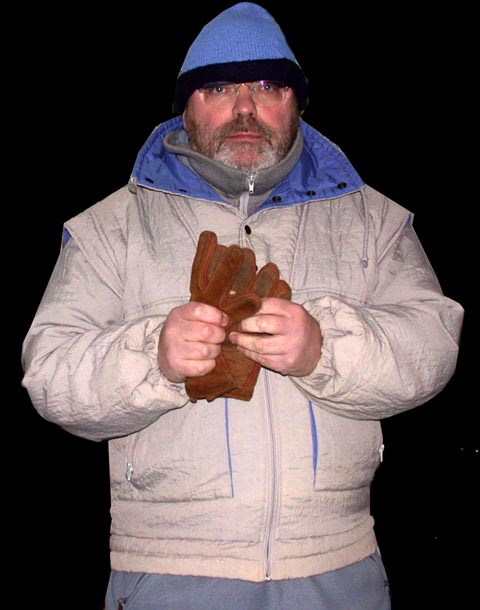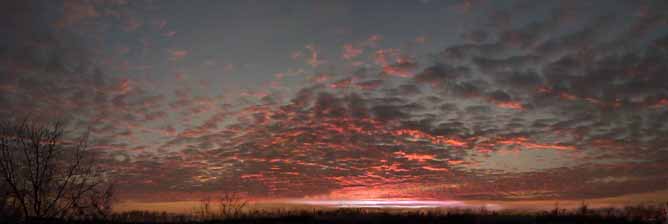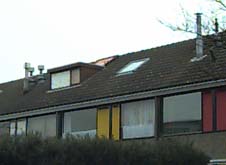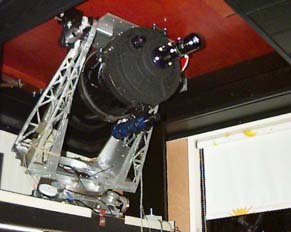get dressed for the evening ....


view from my observatory .... after the buildings in the foreground were removed in Photoshop (composite of four pictures)
to be honest it is more like beneath :-) (a 180 degree panorama)

Equipment, a rooftop observatory and .....
Updated
in March 2009: this observatory has been abandoned in 2008..
get dressed for the evening ....


view from my observatory .... after the buildings in the foreground were removed in Photoshop (composite of four pictures)
to be honest it is more like beneath :-) (a 180 degree panorama)

Over the years I built several telescopes, Newtonians and small refractors. Long before installing my present observatory I built a 12,5 inch f/5.2 Newtonian. That scope proved far too big when using it in my new-built observatory at the top of my house. My gate to the stars is 1.1 x 1.4 meter only! A Celestron 11 inch proofed to be more suitable because of his relative short length. This instrument is now constantly hanging under a platform in a fork mount. An 8 inch Celestron can be installed on top of this platform. The platform can be turned so that the C 11 is on top. When done, virtually the whole sky can be seen with the larger instrument. There is only some obstruction towards the east, below 15-20 degrees altitude, towards the left in the drawing underneath.

Note that the mount is hanging in a rigid frame (yoke) around a hole in the roof. It is very different from my earlier observatory in the backyard. The mount was then placed on 1000 kg concrete in the ground, separated from the floor of the observatory. All in accordance 'to the book'. The new situation causes no problem for visual and photographic observing. Only the heavy washing-machine a few meters from the mount floor should not centrifuge at the same! And another thing is that the chimneys at the right in the picture below sometimes cause so much smoke that I have to stop observing.

Above the roof of the observatory has been opened. The cover (a little bit above and left of the centre of the picture) lays precise on the roof of the house. Below shows the C 11 in the forkmount. The cover (brown) is now closed and the equipment (without the C 8 on the platform) slips just under it. When the cover is opened, the counterweight and/or C 8 is placed on top of the platform. Removal of the counterweight is done within five seconds. Removal of the C 8 takes somewhat longer, but not longer than ten seconds. Closing the cover is can be done in a few seconds. So when it starts raining the observatory can be closed within a few to 20 seconds, depending on the equipment on top of the platform. Luckily I never needed to do it that fast.


Since the Celestrons and SBIG-ccd-cameras I use are wellknown products to astro-photographers, I concentrate beneath to the less standard stuff, my mount.
The mount is home-built, it took nine months of lathing, sawing, welding etc. and above all: thinking. The next drawing + picture give an idea of the result.

 ..........
..........
Left: Fork with Newton in the backyard. The housing is rolled off.
Right: The graph gives an idea of the accuracy of the transmission by motor, worm and wormwheel. In a period of 4 minutes it gives a sinus with ± 5-6 arc seconds. Not too bad for a $ 100 piece. The fork is casted from aluminium. That was another $ 200. Later on I felt that I might have simply used some steel tubes welded together. The mount is very compact and strong. In a jolly mood, I even tried to ride on the Newton and it hold me!
Somehow the periodic error has increased considerily in time, to even over one arcmin. I made the worm spring loaded and that reduced the PE by 2/3.
Developments
In November 1999 I got my ST-8E! Since I have seen superb pictures taken with an 8 inch f/4 Newton and can not use the ST-8 along with the Optec f/3.3 focus reducer, I decided to change my tactics. I built two Newtonians, an 11 cm f/4 and a 20 cm f/4.5. The dimensions of a Newton scope are found here. For a picture of the 11 cm f/4 Newton click here.
The 20 cm is not yet operational, but I have good hopes for it. That good pictures can be taken by an instrument with less than a meter focus, is quite understandable. A 0.0068 mm pixel matches one arc second at a focus of 1400 mm and usually the seeing is several arc seconds.
A year after the arrival of my ST-8E I got my STV. This is intended to be used in taking videos of moon, Jupiter and Saturn. But the main purpose is guiding the two Newtons when I can not find suitable guide stars, as in the case of using an H-alpha filter. Furtheron it is useful as an e-finder, behind a small 135 mm f/2.8 lens, the same lens I use to guide the Newtonians!
In September 2003 I swapped my 8E for an ST-10XME. Also I bought a Vixen Newton 20 cm f/4 plus a Vixen Atlux mount and a Televue Genesis sdf refractor. I also bought a 300 mm f/2.8 Nikkor lens.
Latest
I also bougth a small APO: a Megrez 80 mm f=485 (with flattener/reducer 388 mm), two Meade Schmidt-Newtons (6"f/5 and 10 "f/4) and finally also a Vixen Cassegrain Visac 200L 8 inch f/9. Sold the Vixen Newton and the Genesis, which has been substituted by a William Optics Fluorite Triplet 110/770.
Enough toys for now! I am now looking for a permanent dark observation place.